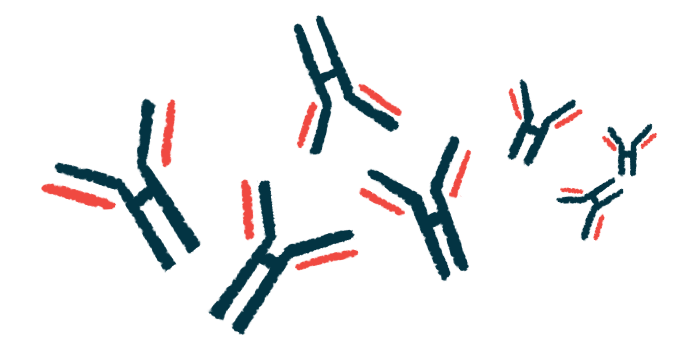Antibodies against EBV viral protein help prevent infection in mice
Targeting its weak points may help in developing vaccines for MS-linked virus

Using antibodies against a viral protein that’s needed for the Epstein-Barr virus (EBV) to invade human cells was found to successfully prevent viral infections and EBV-associated cancer in mice in a new study.
By identifying sites where these antibodies bind to the viral protein — called gp42 — researchers say they’ve located areas of vulnerability that can be leveraged to develop vaccines against EBV, which is a leading cause of multiple sclerosis (MS).
“Our studies identified two independent sites of vulnerability on gp42,” the team wrote.
The antibodies themselves also might have value for preventing or limiting infection in people for whom vaccines are not as effective, the researchers noted.
The study, “Epstein-Barr virus gp42 antibodies reveal sites of vulnerability for receptor binding and fusion to B cells,” was published in the journal Immunity. The work was led by scientists at the National Institute of Allergy and Infectious Diseases (NIAID), which also funded the study.
Viral protein gp42 needed for EBV to invade B-cells
EBV is among the most common human viruses, with about 95% of adults worldwide being infected. Most people will never know they were exposed to the virus, as the infection is often asymptomatic or causes only mild cold-like symptoms. Some individuals, however, will experience infectious mononucleosis, often called mono.
It is now well recognized that EBV is a major environmental risk factor for MS, with virtually all people diagnosed with the neurodegenerative disease having antibodies against the virus — an indicator of a prior infection. The Epstein-Barr virus also has been linked to a number of other autoimmune diseases and is closely associated with certain types of cancer.
To date, there are no vaccines or therapies to specifically prevent or treat EBV infections. But given its now-established link to diseases like MS, efforts are underway to develop them.
EBV works by infecting B-cells, the immune cells that produce antibodies to attack harmful foreign invaders. Its ability to invade these cells depends on the gp42 viral protein, which helps the virus fuse with the cell membrane. After the initial active infection, the virus enters a latent phase, where it lies dormant inside B-cells, sometimes for the rest of a person’s life.
“Theoretically, a vaccine or antibody-based treatment capable of blocking gp42’s ability to bind to or fuse with B cells would prevent EBV infection and, thus, the virus’ ability to persist in those cells,” the NIAID stated in an institute press release announcing the research results.
Study stresses importance of using gp42 in Epstein-Barr vaccines
In the study, the scientists examined whether antibodies that target gp42 might be protective against the virus. Such antibodies were isolated from the immune cells of non-human primates and mice that had previously been exposed to gp42 or a related vaccine.
The scientists identified two new candidates — one, A10, generated in primates and another, 4C12, in mice — that bound to the gp42 viral protein in different regions and worked via different mechanisms to prevent B-cell infection. A10 bound to a site needed for gp42 to bind to its receptor, while 4C12 interfered with a region needed for membrane fusion.
While the two new antibody candidates had a similar ability to prevent EBV from fusing with the virus, A10 was about 30 times more potent for neutralizing EBV infection inside of B-cells in lab studies.
In mice engineered to have a human-like immune system, treatment with the A10 antibody prior to virus exposure led to near complete protection against EBV infection. Meanwhile, most mice given the other antibody had evidence of EBV DNA in their blood. A10 also was the most effective antibody for protecting against an EBV-associated cancer called lymphoma.
The scientists indicated that such antibodies “would likely not be useful as a therapeutic” in humans. But they might have some utility “to reduce EBV-associated disease in immunocompromised persons who may not respond well to vaccines.”
People with certain immunodeficiencies are particularly vulnerable to serious consequences from EBV infection, but can’t mount a sufficient immune response for vaccines to be effective. The antibodies could be an alternative for preventing or controlling EBV infections in those people.
[This work has] uncovered targets that could be exploited in designing treatments and vaccines for this extremely common virus.
More broadly, by identifying the sites where these antibodies bind, the researchers have identified places where gp42 is most vulnerable, and thus could inform the development of future vaccines or therapeutics. In turn, such treatments may help lower the risk of diseases like MS.
“Identification of the sites of vulnerability on gp42 emphasizes the importance of including gp42 as a component of an EBV vaccine,” the researchers concluded.
The NIAID noted in its release that “theoretically, a vaccine or antibody-based treatment capable of blocking gp42’s ability to bind to or fuse with B cells would prevent EBV infection.”
Overall, the NIAID stated, this work has “uncovered targets that could be exploited in designing treatments and vaccines for this extremely common virus.”
In a partnership begun last year, ModeX Therapeutics and Merck are working to advance the development an EBV vaccine that targets four different proteins on the virus, one of which is gp42.







